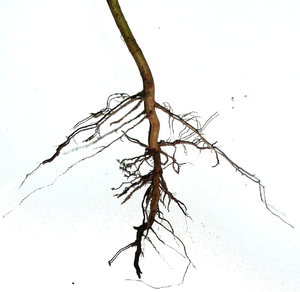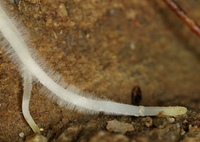Difference between revisions of "Root"
(→Key Stage 3) |
|||
| Line 29: | Line 29: | ||
===Adaptations of the Roots=== | ===Adaptations of the Roots=== | ||
| + | : [[Root]]s have [[Plant Vein|veins]] inside them to [[Water Transport System|transport water]] and [[mineral]]s to the [[Leaf|leaves]]. | ||
: The [[root]]s have [[Root Hair|root hairs]] to increase the [[Surface Area|surface area]] of the [[root]]s. This speeds up [[diffusion]]. | : The [[root]]s have [[Root Hair|root hairs]] to increase the [[Surface Area|surface area]] of the [[root]]s. This speeds up [[diffusion]]. | ||
| − | + | ||
| + | {| class="wikitable" | ||
| + | |- | ||
| + | |[[File:RootHairs.png|center|200px]] | ||
| + | |- | ||
| + | | style="height:20px; width:200px; text-align:center;" |A picture showing the root hairs on a root. | ||
| + | |} | ||
Revision as of 13:12, 13 September 2018
Contents
Key Stage 1
Meaning
Roots are the part of the plant found underground.
About Roots
- Roots collect water for the plant.
- Some roots also have a bulb.
- Some roots can be eaten, like carrots, ginger and parsnips.
Key Stage 2
Meaning
Roots are an organ in plants used to absorb water and minerals into the plant.
Adaptations
- Roots are specially adapted to absorb water and minerals.
- Some roots grow deep into the ground to collect water when there has not been much rain.
- Plants in the desert have roots that spread over a large area so that when it finally rains they can collect as much water as possible.
- Roots have root hairs to allow the roots to collect water easily from the soil.
Key Stage 3
Meaning
The roots are an organ in a plant.
About The Roots
- The roots have a large surface area to collect water and minerals.
- Water and minerals are [[Absorb (biology)|absorbed by diffusion from the soil to the roots.
Adaptations of the Roots
- Roots have veins inside them to transport water and minerals to the leaves.
- The roots have root hairs to increase the surface area of the roots. This speeds up diffusion.
| A picture showing the root hairs on a root. |

